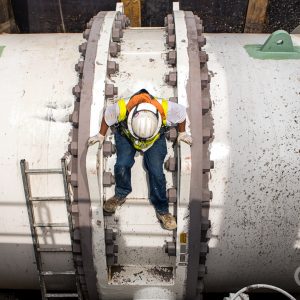The Stream, January 5: Protected U.S. Waters Opened Up to Offshore Drilling
The Global Rundown
The U.S. opens up previously protected parts of the Arctic, Atlantic, and Pacific oceans to offshore oil and gas drilling. Engineers develop wearable sensors that allow crops to measure water use. Brazil reevaluates its hydropower policies amid growing environmental concerns. Icy water floods cities along the coast of Massachusetts as a powerful winter storm hammers the U.S. Northeast. A study finds that the number of ocean ‘dead zones’, areas with zero oxygen, has risen steeply since 1950.
“We’ve never had this level of flooding on top of the snow.” –Donna D. Holaday, mayor of Newburyport, Massachusetts, in reference to flooding along the state’s coast, including in Boston Harbor. A record-breaking winter storm surge, which has swept away cars and prompted several evacuations, is the cause of the flooding. The Boston Herald
Latest WaterNews from Circle of Blue
2018 Preview: What Not to Ignore About Water Infrastructure – Communities need to invest in and maintain water systems.
Cape Town’s “Day Zero” Approaches – Local authorities estimate that taps will be turned off by April 29, 2018.
By The Numbers
70 percent Proportion of Brazil’s electricity that comes from hydropower. The country has constructed numerous mega-dams in recent years, but the government announced this week that it will rethink future hydropower plans due to growing environmental concerns. The Guardian
In context: Popularity of big hydropower projects diminished around the world.
500 Number of ocean dead zones that have been reported near coasts. Dead zones, ocean areas with little or no oxygen, are the result of climate change and sewage run-off. These zones are inhospitable to aquatic life. The Guardian
Science, Studies, And Reports
Engineers at Iowa State University have created wearable plant sensors, which allow for the measurement of water use in crops. The graphene-based sensors could also have other applications, such as monitoring the environment and testing crops for pesticides. Science Daily
On The Radar
As part of a five-year leasing plan, the U.S. Interior Department is opening up the largest area on record to offshore oil and gas drilling. The plan allows for drilling in previously protected parts of the Arctic, Atlantic, and Pacific oceans. Reuters
Kayla Ritter is a recent graduate of Michigan State University, where she studied International Relations and Teaching English to Speakers of Other Languages. She is currently based in Manton, Michigan. Kayla enjoys running, writing, and traveling. Contact Kayla Ritter




